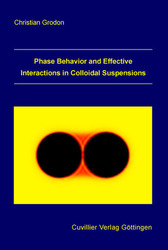| Areas | |
|---|---|
| Serie de libros (96) |
1378
|
| Nachhaltigkeit |
3
|
| Gesundheitswesen |
1
|
| Letra |
2363
|
| Ciencias Naturales |
5406
|
| Matemática | 229 |
| Informática | 319 |
| Física | 980 |
| Química | 1363 |
| Geociencias | 131 |
| Medicina humana | 243 |
| Estomatología | 10 |
| Veterinaria | 108 |
| Farmacia | 147 |
| Biología | 835 |
| Bioquímica, biología molecular, tecnología genética | 121 |
| Biofísica | 25 |
| Nutrición | 45 |
| Agricultura | 1004 |
| Silvicultura | 201 |
| Horticultura | 20 |
| Ecología y conservación de la tierra | 148 |
| Ciencias Ingeniería |
1791
|
| General |
98
|
|
Leitlinien Unfallchirurgie
5. Auflage bestellen |
|
Erweiterte Suche
Phase Behavior and Effective Interactions in Colloidal Suspensions (Tienda española)
Christian Grodon (Autor)Previo
Indice, Datei (32 KB)
Lectura de prueba, Datei (100 KB)
Colloidal suspensions describe particles with size from typically a few nanometers to a few microns which are dispersed in a medium. In physics, in chemistry, and in biology colloids play an important role and the study of colloidal systems underwent a recent renaissance. This is based on the development of experimental techniques, the availability of extensive computer simulations and well-developed theoretical approaches. From a technological point of view, the relevance of micro- and nanostructured materials and the presence of colloids in nature and everyday life motivates study of this rich field.
In this thesis the phase behavior and the effective interactions of colloidal suspensions in bulk, in contact with surfaces, and in confined geometry are studied. For mixtures of particles with hard-core interactions the model introduced by Asakura, Oosawa and Vrij provides an appropriate starting-point. Based on that model the free-volume theory and the density functional theory are employed.
In experimental systems one faces particles with properties such as the size or the shape which are described by a distribution. To capture that issue a generalized approach based on free-volume theory for treating mixtures of colloids and a polydisperse depletion agent is presented. Within that approach it is possible to treat size and morphology polydispersity. A depletion agent with a bimodal distribution possessing two length scales can be studied.
Though the Asakura-Oosawa-Vrij model describes a simple fluid – a mixture of hard spheres and ideal polymer – the phenomenology is rather rich: in contact with a wall one finds layering and wetting effects and in confined geometry of a narrow pore one finds capillary condensation. The competition between both effects manifests itself in thermodynamic properties like the excess colloid adsorption and the solvation force between the two confining walls.
Solvent phase separation complicates the evaluation of interparticle interactions between the solute particles. We address this question for the wall-colloid and the colloid-colloid geometry. For a non-spherical particle the effect of curvature on thermodynamic quantities is studied.
| ISBN-10 (Impresion) | 3867272239 |
| ISBN-13 (Impresion) | 9783867272230 |
| ISBN-13 (E-Book) | 9783736922235 |
| Idioma | Inglés |
| Numero de paginas | 136 |
| Edicion | 1 |
| Volumen | 0 |
| Lugar de publicacion | Göttingen |
| Lugar de la disertacion | Stuttgart |
| Fecha de publicacion | 25.04.2007 |
| Clasificacion simple | Tesis doctoral |
| Area |
Física
|
| Palabras claves | Statistische Physik, Flüssigkeiten, Kolloide, Phasenverhalten, Entropische Kräfte. |








